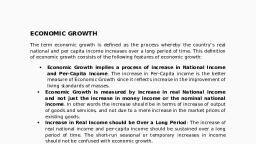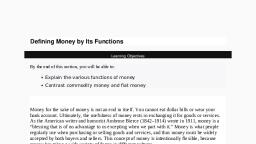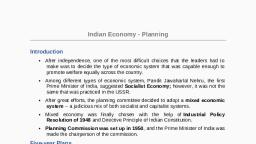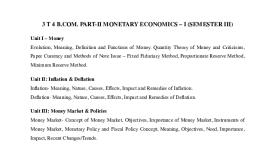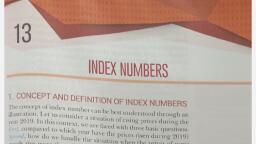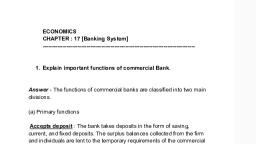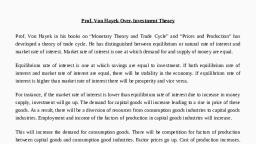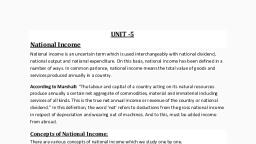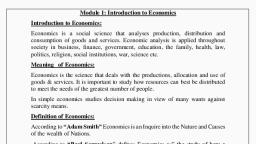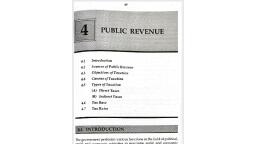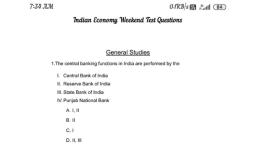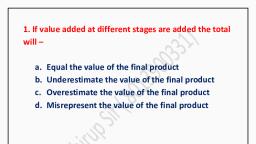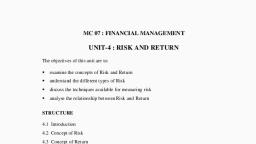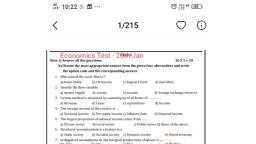Page 1 :
Inflation & Deflation – Definition, Causes, Effects, Basics, Inflation happens when the price of goods and services increase, while deflation takes place when the price of the goods and services decrease in the country. Inflation and deflation are the opposite sides of the same coin., Maintaining the balance between these two economic conditions, i.e. inflation and deflation is essential as the economy can quickly swing from one condition to the other as a result of these two conditions. The Reserve Bank of India keeps an eye on the levels of price changes and controls deflation or inflation by conducting monetary policy, such as setting interest rates in India., Inflation, Inflation is the rate at which the prices for goods and services increase. Inflation often affects the buying capacity of consumers. Most Central banks try to limit inflation in order to keep their respective economies functioning efficiently. There are certain advantages as well as disadvantages to inflation., Inflation refers to the increase in the prices of the goods and services of daily use, such as food, housing, clothing, transport, recreation, consumer staples, etc. Inflation is measured by taking into consideration the average price change in a basket of commodities and services over a period of time., Inflation is calculated in India by the Ministry of Statistics and Programme Implementation., A simple example would be, suppose a kg of apple cost Rs.100 in 2019 and it cost Rs.110 in 2020, then there would be a 10% increase in the cost of a kg of apple. In the same way, many commodities and services whose prices have raised over time are put in a group and the percentage is calculated by keeping a year as the base year. The percentage of increase in prices of the group of commodities is the rate of inflation., Causes of Inflation, 4 September 2021 by Tejvan Pettinger, Inflation means there is a sustained increase in the price level. The main causes of inflation are either excess aggregate demand (AD) (economic growth too fast) or cost-push factors (supply-side factors)., Summary of the main causes of inflation, – aggregate demand growing faster than aggregate supply (growth too rapid), – For example, higher oil prices feeding through into higher costs., – increasing cost of imported goods, and also the boost to domestic demand., – higher wages increase firms costs and increase consumers’ disposable income to spend more., – High inflation expectations causes workers to demand wage increases and firms to push up prices., Video summary, Factors affecting inflation, 1. Demand-pull inflation, If the economy is at or close to full employment, then an increase in aggregate demand (AD) leads to an increase in the price level (PL). As firms reach full capacity, they respond by putting up prices leading to inflation. Also, near full employment with labour shortages, workers can get higher wages which increase their spending power., AD can increase due to an increase in any of its components C+I+G+X-M, We tend to get demand-pull inflation if economic growth is above the . The long-run trend rate of economic growth is the average sustainable rate of growth and is determined by the growth in productivity. Demand-pull inflation can be caused by factors such as, Higher wages., Increased consumer confidence., Rising house prices – causing positive wealth effect., Example of demand-pull inflation in the UK, In the 1980s, the UK experienced rapid economic growth. The government cut interest rates and also cut taxes. House prices rose by up to 30% – fuelling a positive and a rise in consumer confidence. This increased confidence led to higher spending, lower saving and an increase in borrowing. However, the rate of economic growth reached 5% a year – well above the UK’s long-run trend rate of 2.5 %. The result was a rise in inflation as firms could not meet demand. It also led to a current account deficit. You can read more about at the ., 2. Cost-push inflation, If there is an increase in the costs of firms, then businesses will pass this on to consumers. There will be a shift to the left in the SRAS., Cost-push inflation can be caused by many factors, i) Rising wages If trades unions can present a united front then they can bargain for higher wages. Rising wages are a key cause of cost-push inflation because wages are the most significant cost for many firms. (higher wages may also contribute to rising demand) See also, ii) Import prices One-third of all goods are imported in the UK. If there is a devaluation, then import prices will become more expensive leading to an increase in inflation. A devaluation/depreciation means the Pound is worth less. Therefore we have to pay more to buy the same imported goods., In 2011/12, the UK experienced a rise in cost-push inflation, partly due to the depreciation of the Pound against the Euro. (also due to higher taxes), iii) Raw material prices The best example is the price of oil. If the oil price increase by 20% then this will have a significant impact on most goods in the economy and this will lead to cost-push inflation. E.g., in 1974 there was a spike in the price of oil causing a period of high inflation around the world., 4. Higher inflation expectations, Once inflation sets in, it is difficult to reduce inflation. For example, higher prices will cause workers to demand higher wages causing a . Therefore, expectations of inflation are important. If people expect high inflation, it tends to be self-fulfilling. When expectations are low, temporary rise in prices tend to be short-lived and fade away., 5. Printing more money, If the Central Bank prints more money, you would expect to see a rise in inflation. This is because the money supply plays an important role in determining prices. If there is more money chasing the same amount of goods, then prices will rise. Hyperinflation is usually caused by an extreme increase in the money supply., However, in exceptional circumstances – such as liquidity trap/recession, it is possible to increase the money supply without causing inflation. This is because, in a recession, an increase in the money supply may just be saved, e.g. banks don’t increase lending but just keep more bank reserves., See:, 6. Higher taxes, If the government put up taxes, such as VAT and Excise duty, this will lead to higher prices, and therefore CPI will increase. However, these tax rises are likely to be one-off increases. There is even a measure of inflation (CPI-CT) that ignores the effect of temporary tax rises/decreases., CPI-CT is less volatile because it ignores the effect of taxes. In 2010, some of the UK CPI inflation was due to rising taxes., 7. Declining productivity, If firms become less productive and allow costs to rise, this invariably leads to higher prices., 8. Profit push inflation, When firms push up prices to get higher rates of inflation. This is more likely to occur during strong economic growth., 9. Monetary and fiscal policy, The attitude of the monetary authorities is important; for example, if there was an increase in AD and the monetary authorities accommodated this by increasing the money supply then there would be a rise in the price level., 9 Common Effects of Inflation, Inflation is an economic term describing the sustained increase in prices of goods and services within a period. To some, signifies a struggling economy, whereas others see it as a sign of a prospering economy. Here, we examine some of the residual effects of inflation., KEY TAKEAWAYS, Inflation, the steady rise of prices for goods and services over a period, has many effects, good and bad., Inflation erodes purchasing power or how much of something can be purchased with currency., Because inflation erodes the value of cash, it encourages consumers to spend and stock up on items that are slower to lose value., It lowers the cost of borrowing and reduces unemployment., 1. Erodes Purchasing Power, This first effect of inflation is really just a different way of stating what it is. Inflation is a decrease in the of currency due to a rise in prices across the economy. Within living memory, the average price of a cup of coffee was a dime. Today the price is closer to three dollars.1, Such a price change could conceivably have resulted from a surge in the popularity of coffee, or price pooling by a cartel of coffee producers, or years of devastating drought, flooding, or conflict in a key coffee-growing region. In those scenarios, the price of coffee products would rise, but the rest of the economy would carry on largely unaffected. That example would not qualify as inflation since only the most caffeine-addled consumers would experience significant depreciation in their overall purchasing power., Inflation requires prices to rise across a "basket" of goods and services, such as the one that comprises the most common measure of price changes, the . When the prices of goods that are non-discretionary and impossible to substitute—food and fuel—rise, they can affect inflation all by themselves. For this reason, economists often strip out food and fuel to look at , a less measure of price changes., 2. Encourages Spending, Investing, A predictable response to declining purchasing power is to buy now, rather than later. Cash will only lose value, so it is better to get your shopping out of the way and stock up on things that probably won't lose value., For consumers, that means filling up gas tanks, stuffing the freezer, buying shoes in the next size up for the kids, and so on. For businesses, it means making that, under different circumstances, might be put off until later. Many investors buy gold and other precious metals when inflation takes hold, but these assets' volatility can cancel out the benefits of their insulation from price rises, especially in the short term., Over the long term, equities have been among the best hedges against inflation. At close on Dec. 12, 1980, a share of Apple Inc. (AAPL) cost $29 in current (not inflation-adjusted) dollars. According to Yahoo Finance, that share would be worth $7,035.01 at close on Feb. 13, 2018, after adjusting for and . The (BLS) CPI calculator gives that figure as $2,438.33 in 1980 dollars, implying a (inflation-adjusted) gain of 8,346%.2, Say you had buried that $29 in the backyard instead. The value wouldn't have changed when you dug it up, but the purchasing power would have fallen to $10.10 in 1980 terms; that's about a 65% depreciation. Of course not every stock would have performed as well as Apple: you would have been better off burying your cash in 1980 than buying and holding a share of Houston Natural Gas, which would merge to become .3, 3. Causes More Inflation, Unfortunately, the urge to spend and invest in the face of inflation tends to boost inflation in turn, creating a potentially catastrophic feedback loop. As people and businesses spend more quickly in an effort to reduce the time they hold their depreciating currency, the economy finds itself awash in cash no one particularly wants. In other words, the supply of money outstrips the demand, and the price of money—the purchasing power of currency—falls at an ever-faster rate., When things get really bad, a sensible tendency to keep business and household supplies stocked rather than sitting on cash devolves into hoarding, leading to empty grocery store shelves. People become desperate to offload currency so that every payday turns into a frenzy of spending on just about anything so long as it's not ever-more-worthless money., Note: By December 1923, an index of the cost of living in Germany increased to a level of more than 1.5 trillion times its pre-WW I measure.4, The result is , which has seen Germans papering their walls with the (the 1920s), Peruvian cafes raising their prices multiple times a day (the 1980s), Zimbabwean consumers hauling around wheelbarrow-loads of million- and billion-Zim dollar notes (the 2000s), and Venezuelan thieves refusing even to steal bolívares (2010s)., 4. Raises the Cost of Borrowing, As these examples of hyperinflation show, states have a powerful incentive to keep price rises in check. For the past century in the U.S., the approach has been to manage inflation using . To do so, the (the U.S. central bank) relies on the relationship between . If are low, companies and individuals can borrow cheaply to start a business, earn a degree, hire new workers, or buy a shiny new boat. In other words, low rates encourage spending and investing, which generally stokes inflation in turn., By raising interest rates, central banks can put a damper on these rampaging . Suddenly the monthly payments on that boat, or that corporate bond issue, seem a bit high. Better to put some money in the bank, where it can earn interest. When there is not so much cash sloshing around, money becomes more scarce. That scarcity increases its value, although as a rule, central banks don't want money literally to become more valuable: they fear outright nearly as much as they do hyperinflation. Rather, they tug on interest rates in either direction in order to maintain inflation close to a target rate (generally 2% in and 3% to 4% in )., Another way of looking at is through the . If the amount of money is growing faster than the economy, the money will be worthless and inflation will ensue. That's what happened when Weimar Germany fired up the printing presses to pay its World War I reparations, and when Aztec and Inca bullion flooded Habsburg Spain in the 16th century., When central banks want to raise rates, they generally cannot do so by simple fiat; rather they sell government securities and remove the proceeds from the money supply. As the money supply decreases, so does the rate of inflation.89, 5. Lowers the Cost of Borrowing, When there is no central bank, or when central bankers are beholden to elected politicians, inflation will generally lower borrowing costs., Say you borrow $1,000 at a 5% annual rate of interest. If inflation is 10%, the real value of your debt is decreasing faster than the combined interest and principal you're paying off. When levels of household debt are high, politicians find it electorally profitable to print money, stoking inflation and whisking away voters' obligations. If the government itself is heavily indebted, politicians have an even more obvious incentive to print money and use it to pay down debt. If inflation is the result, so be it (once again, Weimar Germany is the most infamous example of this phenomenon)., Politicians' occasionally detrimental fondness for inflation has convinced several countries that fiscal and monetary policymaking should be carried out by independent central banks. While the Fed has a statutory mandate to seek maximum employment and steady prices, it does not need a congressional or presidential go-ahead to make its rate-setting decisions. That does not mean the Fed has always had a totally free hand in policy-making, however. Former Minneapolis Fed President Narayana Kocherlakota wrote in 2016 that the Fed's independence is "a post-1979 development that rests largely on the restraint of the president."10, 6. Reduces Unemployment, There is some evidence that inflation can push down . Wages tend to be , meaning that they change slowly in response to economic shifts. theorized that the resulted in part from wages' downward stickiness. Unemployment surged because workers resisted pay cuts and were fired instead (the ultimate pay cut).11, The same phenomenon may also work in reverse: wages' upward stickiness means that once inflation hits a certain rate, employers' real payroll costs fall, and they're able to hire more workers., 12, That hypothesis appears to explain the inverse —a relationship known as the —but a more common explanation puts the onus on unemployment. As unemployment falls, the theory goes, employers are forced to pay more for workers with the skills they need. As wages rise, so does consumers' spending power, leading the economy to heat up and spur inflation; this model is known as inflation.13, 12, 7. Increases Growth, Unless there is an attentive central bank on hand to push up interest rates, inflation discourages saving, since the purchasing power of deposits erodes over time. That prospect gives consumers and businesses an incentive to spend or invest. At least in the short term, the boost to spending and investment leads to economic growth. By the same token, inflation's negative correlation with unemployment implies a tendency to put more people to work, spurring growth., This effect is most conspicuous in its absence. In 2016, central banks across the developed world found themselves vexingly unable to coax inflation or growth up to healthy levels. Cutting interest rates to zero and below did not seem to be working. Neither did the buying of trillions of dollars worth of bonds in a money-creation exercise known as ., This conundrum recalled Keynes's , in which central banks' ability to spur growth by increasing the money supply (liquidity) is rendered ineffective by cash hoarding, itself the result of economic actors' risk aversion in the wake of a financial crisis. Liquidity traps cause disinflation, if not deflation.14, In this environment, moderate inflation was seen as a desirable growth driver, and markets welcomed the . In February 2018, however, markets sold off steeply due to worries that inflation would lead to a rapid increase in interest rates.15, 8. Reduces Employment, Growth, Wistful talk about inflation's benefits is likely to sound strange to those who remember the economic woes of the 1970s. When growth is slow, unemployment is high, and inflation is in the double digits, you have what a British Tory MP in 1965 dubbed "stagflation.", Economists have struggled to explain . Early on, did not accept that it could happen, since it appeared to defy the inverse correlation between unemployment and inflation described by the Phillips curve. After reconciling themselves to the reality of the situation, they attributed the most acute phase to the supply shock caused by the 1973 oil embargo: as transportation costs spiked, the theory went, the economy ground to a halt. In other words, it was a case of ., Evidence for this idea can be found in five consecutive quarters of decline, ending with a healthy expansion in the fourth quarter of 1974. But the drop in productivity in the third quarter of 1973 occurred before Arab members of OPEC shut off the taps in October of that year., 16, The kink in the timeline points to another, earlier contributor to the 1970s' malaise, the so-called . Following other countries' departures, the U.S. pulled out of the Bretton Woods Agreement in August 1971, ending the dollar's convertibility to gold.17 The greenback plunged against other currencies: for example, a dollar bought 3.48 Deutsche marks in July 1971, but just 1.75 in July 1980. Inflation is a typical result of depreciating currencies.18, And yet even dollar devaluation does not fully explain stagflation since inflation began to take off in the mid-to-late 1960s (unemployment lagged by a few years). As see it, the Fed was ultimately to blame. money stock nearly doubled in the decade prior to 1970, nearly twice as fast as the (GDP), leading to what economists commonly describe as "too much money chasing too few goods," or ., , who emerged in the 1970s as a foil to Keynesian hegemony, won the argument at the polls when Reagan swept the popular vote and electoral college. They blamed high taxes, burdensome regulation, and a generous welfare state for the malaise; their policies, combined with aggressive, monetarist-inspired tightening by the Fed, put an end to stagflation., 9. Weakens or Strengthens Currency, High inflation is usually associated with a slumping exchange rate, though this is generally a case of the weaker currency leading to inflation, not the other way around. Economies that import significant amounts of goods and services—which, for now, is just about every economy—must pay more for these imports in local-currency terms when their currencies fall against those of their trading partners., Say that Country X's currency falls 10% against Country Y's. The latter doesn't have to raise the price of the products it exports to Country X for them to cost Country X 10% more; the weaker exchange rate alone has that effect. Multiply cost increases across enough trading partners selling enough products, and the result is economy-wide inflation in Country X., But once again, inflation can do one thing, or the polar opposite, depending on the context. When you strip away most of the global economy's moving parts it seems perfectly reasonable that rising prices lead to a weaker currency. In the wake of Trump's election victory, however, rising inflation expectations drove the dollar higher for several months. The reason was that —almost certainly the lowest they've been in human history—making markets likely to jump on any opportunity to earn a bit of money for lending, rather than paying for the privilege (as the holders of $11.7 trillion in sovereign bonds were doing in June 2016, according to Fitch).19, Because the U.S. has a central bank, rising inflation generally translates into higher interest rates. The Fed has raised the federal funds rate five times following the election, from 0.5%–0.75% to 1.5%–1.75%.20, Methods to Control Inflation, Inflation is generally controlled by the Central Bank and/or the government. The main policy used is monetary policy (changing interest rates). However, in theory, there are a variety of tools to control inflation including:, Monetary policy – Higher interest rates reduce demand in the economy, leading to lower economic growth and lower inflation., Control of money supply – Monetarists argue there is a close link between the money supply and inflation, therefore controlling money supply can control inflation., Supply-side policies – policies to increase the competitiveness and efficiency of the economy, putting downward pressure on long-term costs., Fiscal policy – a higher rate of income tax could reduce spending, demand and inflationary pressures., Wage controls – trying to control wages could, in theory, help to reduce inflationary pressures. However, apart from the 1970s, it has been rarely used., Monetary Policy, In a period of rapid economic growth, demand in the economy could be growing faster than its capacity to meet it. This leads to inflationary pressures as firms respond to shortages by putting up the price. We can term this . Therefore, reducing the growth of aggregate demand (AD) should reduce inflationary pressures., The Central bank could increase interest rates. Higher rates make borrowing more expensive and saving more attractive. This should lead to lower growth in consumer spending and investment. See more on, A higher interest rate should also lead to a higher exchange rate, which helps to reduce inflationary pressure by:, Making imports cheaper. (lower price of imported goods), Reducing demand for exports., Increasing incentive for exporters to cut costs., Interest rates were increased in the late 1980s / 1990 to try and control the rise in inflation., Inflation target, UK inflation target set in 1998., As part of monetary policy, many countries have an inflation target (e.g. UK inflation target of 2%, +/-1). The argument is that if people believe the inflation target is credible, then it will help to lower inflation expectations. If inflation expectations are low, it becomes easier to control inflation., Countries have also made Central Bank independent in setting monetary policy. The argument is that an independent Central Bank will be free from political pressures to set low-interest rates before an election., Fiscal Policy, The government can increase taxes (such as income tax and VAT) and cut spending. This improves the government’s budget situation and helps to reduce demand in the economy., Both these policies reduce inflation by reducing the growth of aggregate demand. If economic growth is rapid, reducing the growth of AD can reduce inflationary pressures without causing a recession., If a country had high inflation and negative growth, then reducing aggregate demand would be more unpalatable as reducing inflation would lead to lower output and higher unemployment. They could still reduce inflation, but, it would be much more damaging to the economy., Other Policies to Reduce Inflation, Wage Control, If inflation is caused by wage inflation (e.g. powerful unions bargaining for higher real wages), then limiting wage growth can help to moderate inflation. Lower wage growth helps to reduce cost-push inflation and helps to moderate demand-pull inflation., However, as the UK discovered in the 1970s, it can be difficult to control inflation through incomes policies, especially if the unions are powerful., Monetarism, seeks to control inflation by controlling the money supply. Monetarists believe there is a strong link between the money supply and inflation. If you can control the growth of the money supply, then you should be able to bring inflation under control. Monetarists would stress policies such as:, Higher interest rates (tightening monetary policy), Reducing budget deficit (deflationary fiscal policy), Control of money being created by the government, However, in practice, the link between is less strong., Supply Side Policies, Often inflation is caused by persistent uncompetitiveness and rising costs. Supply-side policies may enable the economy to become more competitive and help to moderate inflationary pressures. For example, more flexible labour markets may help reduce inflationary pressure., However, can take a long time, and cannot deal with inflation caused by rising demand., Ways to Reduce Hyperinflation – change currency, In a period of hyperinflation, conventional policies may be unsuitable. Expectations of future inflation may be hard to change. When people have lost confidence in a currency, it may be necessary to introduce a new currency or use another like the dollar (e.g. )., Ways to reduce Cost-Push Inflation, (e.g. rising oil prices can lead to inflation and lower growth. This is the worst of both worlds and is more difficult to control without leading to lower growth., IMPACT OF INFLATION, The effects of unanticipated inflation can be categorized under two broad headings:, (a) Effect on distribution of income and wealth, (b) Effect on economic growth, (a) Effects of Inflation on Distribution of Income and Wealth:, During inflation, usually people experience rise in incomes. But some people gain during inflation at the expense of others. Some individuals gain because their money incomes rise more rapidly than the prices and some lose because prices rise more rapidly than their incomes during inflation. Thus, it redistributes income and wealth., (i) Creditors and debtors:, Borrowers gain and lenders lose during inflation because debts are fixed in rupee terms. When debts are repaid their real value declines by the price level increase and, hence, creditors lose. An individual may be interested in buying a house by taking loan of Rs.10 lakhs from an institution for 5 years., The borrower now welcomes inflation since he will have to pay less in real terms than when it was borrowed. Lender, in the process, loses since the rate of interest payable remains unaltered as per agreement. Because of inflation, the borrower is given ‘dear’ rupees, but pays back ‘cheap’ rupees., (Note: In reality, the loan-giving institution makes adequate safeguard against the erosion of real value.), (ii) Bond and debenture-holders:, Bondholders earn fixed interest income. These people suffer a reduction in real income when inflation occurs. In other words, the value of one’s savings decline if the interest rate they receive is less than the inflation rate. Similarly, beneficiaries from life insurance programs are also hit badly by inflation since real value of savings deteriorate., (iii) Investors:, People who invest their money in shares during inflation are expected to gain since the possibility of earning of business profit brightens. Higher profit induces owners of firm to distribute profit among investors or shareholders., (iv) Salaried people and wage-earners:, Anyone earning a fixed income is worse-off by inflation. Sometimes, unionized worker succeeds in raising wage rates of white-collar workers as a compensation against price rise. But wage-rate changes with a long time lag. Usually, wage rate increases always lag behind price increases. Hence, inflation results in a reduction in real purchasing power of fixed income-earners., Result:, Thus, there occurs a redistribution of income and wealth. It is said that rich becomes richer and poor becomes poorer during inflation., These effects of inflation may persist if inflation is unanticipated. However, the redistributive burdens of inflation on income and wealth are most likely to be minimal if inflation is anticipated by the people. With anticipated inflation, people can build up their strategies to cope with inflation., If the annual rate of inflation in an economy is anticipated correctly people will try to protect them against losses resulting from inflation., However, it is difficult to anticipate inflation accurately. Further, even if it is anticipated, it cannot be perfect. In addition, adjustment with the new expected inflationary conditions may not be possible for all categories of people. Thus, adverse redistributive effects are likely to occur., Finally, anticipated inflation may also be costly to the society. If people’s expectation regarding future price rise become stronger they will hold less liquid money. Mere holding of cash balances during inflation is unwise since its real value declines. That is why people use their money balances in buying real estate, gold, jewelry, etc. Such investment is referred to as unproductive investment. Thus, during inflation of anticipated variety, there occurs a diversion of resources from priority to non-priority or unproductive sectors., (b) Effect on Production and Economic Growth:, Inflation may or may not result in higher output. Below the full employment stage, inflation has a favorable effect on production. In general, profit is a rising function of the price level. An inflationary situation gives an incentive to businessmen to raise prices of their products so as to earn higher volume of profit. Rising price and rising profit encourage firms to make larger investments., Deflation, Deflation is generally the decline in the prices for goods and services that occur when the rate of inflation falls below 0%. Deflation will take place naturally, if and when the money supply of an economy is limited. Deflation in an economy indicates deteriorating conditions., Deflation is normally linked with significant unemployment and low productivity levels of goods and services. The term “Deflation” is often mistaken with “disinflation.” While deflation refers to a decrease in the prices of goods and services in an economy, disinflation is when inflation increases at a slower rate., Deflation Definition, What is Deflation, Deflation occurs when the prices of good and services start to decline throughout the economy. It is generally associated with a contraction in the money supply. In other words, the debt within the nation starts to decline, or economic growth outpaces the growth in the amount of money in the economy., Deflation can be good in the short-term as it can boost disposable income and increase demand. However, in the long-term, if consumers start to expect deflation year on year, they start to push purchasing decisions back in the hope they will get the product even cheaper next year. We then see permanent deflation which can depress economic output., Key Points, Deflation occurs when prices in the economy are declining., If deflation is persistent, it can create a drag on the economy as consumers push back spending as goods will become cheaper year on year., Types of Deflation, Macro Level Deflation, We can look at deflation two ways. First of all, we can look at it on a macro level. So how average prices across the nation are being affected. Deflation could occur on a macro level if average prices based on the CPI are in decline., For example, prices of iPhones may go up, but if prices of everything else are declining, we see deflation on a macro level. To put it another way; macro deflation refers to prices falling on average across all the goods and service in the economy., Micro Level Deflation, Second of all, we can look at deflation on a micro level. In other words, how the prices of a specific good are being affected. So the price of an iPhone may start to decline, thereby creating deflation. To put it another way; micro deflation refers to prices falling on a specific product rather than everything made in the economy., Causes of deflation, Readers Question: What is the cause of deflation?, Deflation involves a fall in the price level – a negative rate of inflation. From a very basic standpoint, there are two main potential causes of deflation:, A fall in aggregate demand (AD), A shift to the right of aggregate supply (AS) – i.e. lower costs of production through improved technology., Deflation usually occurs during a deep recession, when there is a sustained fall in demand and output. This deflation may occur in the aftermath of credit boom and bust or severe tightening of monetary policy/fiscal policy. Monetarists emphasize the role of the money supply – falling money supply and/or falling velocity of circulation causing a fall in the price level., In rare circumstances, rapid growth in technology may enable lower prices, whilst at the same time increasing output. This could be termed ‘benign deflation’ as output increases. Also, a rapid drop in oil prices may cause a negative inflation rate., 1. Deflation caused by falling aggregate demand (AD), This simple AD/AS model shows that a fall in AD can cause a lower price level., AD could fall due to :, Fiscal austerity. If the government cut spending and cut the wages of public sector workers – there will be a fall in spending and AD will fall. This occurred in southern Europe in the Eurozone crisis of 2012-16., Credit crunch/stock market fall. In the aftermath of the Wall Street Crash 1929, many banks went bust. This caused a fall in the money supply and a fall in bank lending. With contraction in money supply and fall in spending, prices fell. Firms were trying to cut prices to attract customers to buy surplus stock., . In a serious recession, people become pessimistic about the future. Therefore, they are likely to increase their personal savings and cut back on spending. This causes lower demand and again firms may need to try and cut prices to encourage sales. In Japan in the 2000s, there were periods of deflation because customers were unwilling to spend., Debt deleveraging. After a credit bubble, people may be seeking to pay off debts and have to reduce their spending., Overvalued exchange rate and high interest rates to maintain the value of the currency., Tight monetary policy – higher interest rates., Deflation spiral, Deflation can become a self-reinforcing loop. Falling prices create circumstances for prices to continue falling., With falling prices – firms want to cut wages – lower wages lead to less spending (AD) and lower costs., Falling prices lead to a decline in confidence, and therefore lower spending and lower investment., Deflation leads to expectations of falling prices – people won’t spend unless prices fall and they can delay spending until they do., Deflation caused by lower costs, This is deflation caused by lower costs of production. This could be due to lower oil prices or improved technology, e.g. development of computer chips which enables price of manufactured goods to fall., This is considered a ‘benign period of deflation because we get lower prices – but output is also rising. We get the best of both worlds., Examples of deflation, Deflation of the 1920s, In the 1920s, the UK experienced several periods of deflation. This was due to several factors. One important factor was that the government tried to maintain the value of Pound Sterling against the dollar at close to $4.85 (this was the pre-war gold standard. The UK returned to this level in 1925). The high pound, made imports cheaper (helping keep prices low). But, the overvalued exchange rate also made UK exporters uncompetitive. Many firms were forced to try and cut costs to retain their export markets. This created a strong downward pressure on prices., In addition, the economy faced:, Relatively tight fiscal policy (trying to reduce budget deficit through higher taxes, lower spending) After the end of the war, the government cut spending quickly., Relatively tight monetary policy. Interest rates were kept high to keep the value of the Pound high. Real interest rates were often over 5% (compare that to negative real interest rates we see today), Deflation of 1930s, The UK experienced more deflation during the 1930s because of the extent of the recession/great depression. The US also experienced a period of deflation. One major cause of the US deflation was a fall in the money supply following the failure of many banks in the aftermath of the Wall St crash and the Great Depression., Deflation of 2009 during the great recession, The UK experienced a period of temporary deflation during 2009 (if we use the RPI method, which includes interest payments). However, CPI inflation which excludes mortgage interest payments stayed positive., The inflation picture in the UK was complicated:, There was a sharp fall in output causing spare capacity and higher unemployment. But, there was significant wage and price rigidity., The UK also experienced a sharp devaluation in the exchange rate which tends to contribute to inflation (e.g. imports more expensive), There was also substantial cost-push factors, such as rising oil prices., Monetary policy was very loose. Interest rates cut to 0.5% and from March 2009 a programme of Quantitative easing trying to increase the money supply., Therefore, overall the recession did not cause actual deflation., Deflation in the Eurozone, By contrast to the UK, countries in the periphery of the Eurozone, such as Greece and (to a lesser extent Spain) have experienced deflation., Source:, This is because, They cannot devalue in the Euro, so they are seeking to regain competitiveness through (cutting prices and costs), Fiscal austerity – cutting spending, including cutting public sector wages, Due to the credit crunch, bank lending has fallen significantly; this contributed to a fall in the money supply., Why recession may not cause deflation, Periods of actual deflation are relatively rare. This is because prices and wages can be sticky downwards. For example, if aggregate demand falls, firms may like to reduce wages, but workers resist nominal wage cuts. Firms also might keep prices the same, rather than cut them. Therefore, even in recessions, inflation often stays positive. (though in a recession, rather confusingly we may talk of ‘deflationary pressures’) (See: at NY Times for more on wage rigidity), Deflation usually occurs during a prolonged and severe recession. It is a recession where demand falls significantly, and eventually, firms start to cut prices in a desperate attempt to boost spending. Also, if unemployment rises sufficiently, then we may start to see nominal wage cuts which feed through into lower prices., How Does Deflation Impact Consumers?, Deflation is a decrease in the general price level of goods and services in a country. It is the opposite of inflation, which is when general price levels in a country are rising. In the short-term, deflation impacts consumers positively because it increases their , allowing them to save more money as their income increases relative to their expenses., Deflation also alleviates debt burdens because consumers are able to deleverage. However, in the long-term, deflation negatively impacts consumers. The last time the world experienced an entrenched period of deflation that lasted for many years was the .1, KEY TAKEAWAYS, In the short-term, deflation impacts consumers positively because it increases their purchasing power, allowing them to save more money as their income increases relative to their expenses., In the long-term, deflation creates higher rates of unemployment and can eventually cause consumers to default on their debt obligations., The last time the world experienced an entrenched period of deflation that lasted for many years was the Great Depression., Consumer Price Index (CPI) Measures Deflation, In the U.S., the is the most common method for evaluating inflation rates (and conversely, deflation rates).2 Most countries compare changes in consumer prices by comparing the change in the price of a basket of diverse goods and products to an index., The CPI is the most commonly referenced index in the U.S. The economy is experiencing deflation when the change in prices in one period is lower than the next, revealing that the CPI index has declined., Deflation Upends Economic Growth and Stability, When there are small drops in the prices of certain products, such as food or energy, this can be good for the economy because it has a positive effect on consumer spending. However, a widespread fall in prices presents a very severe, negative situation for economic growth and stability in the long-term. Over time, the factors that contribute to deflation are disastrous for consumers and for the economy., Deflation typically occurs during or after economic crises. During a or depression, consumption and investment activity decreases, impacting the overall output of the economy.3, Deflation Creates Higher Rates of Unemployment, At the beginning of a deflationary period, there is a temporary lull when consumers' income remains steady while prices decline. Eventually, these falling prices begin to have an impact on the health of companies. In response to falling revenue, companies are forced to cut pay and layoff workers. This results in increased , incomes declining and consumer confidence decreasing., When incomes decline and confidence is lowered, consumers decrease their spending. This creates another situation where companies are pushed to cut their prices in order to sell their products.4, Debt Increases Relative to Household Budgets, Despite decreases in incomes, debt loads and interest payments remain constant during periods of deflation. However, on a relative basis, debt and interest payments increase because they eat up a larger portion of household budgets., Individuals who become unemployed may have a hard time finding new employment and may spend their savings in order to survive. Many consumers are forced into during periods of deflation. Consumers may also lose any assets that are purchased on credit, such as homes or automobiles, and default on student loans and credit card payments.5, Deflationary Periods Are Dangerous for the Economy, Consumers on fixed incomes, and individuals who do not lose employment or have their pay cut, may be spared financial difficulties during deflationary periods. However, a deflationary period is dangerous for a country's economy and even individuals who are spared economic hardships themselves will be living in an environment where businesses are closing and people in their community are economically displaced., Deflation: Causes, Effects and Control, Deflation is the opposite of inflation. Just as inflation is a phenomenon of rising prices, deflation is a phenomenon of falling prices. In the words of Crowther, “Deflation is that state of the economy where the value of money is rising or the prices are falling.” No doubt deflation is associated with falling prices, but it is not that each and every fall in price will be termed as deflation., Only those falls in prices which result in unemployment, overproduction and fall in the economic activity are deflationary. In short, deflation is a situation in which falling prices are accompanied by falling levels of employment, output and income., Causes of Deflation:, Deflation is a situation in which falling prices are accompanied by falling levels of employment, income and output. Deflation may be due to certain natural causes, or it may be due to a deliberate policy of the government., The following are the important causes of deflation:, 1. Keynes’ Explanation:, Keynes had developed a systematic theory to explain the causes of deflation (or depression)., (i) Deficient Aggregate Demand:, The main reason for deflation is the deficiency of aggregate demand which leads to over-production and unemployment. Aggregate demand consists of aggregate consumption expenditure and aggregate investment expenditure., (ii) Less Investment Expenditure:, Private investment is governed by marginal efficiency of capital (MEC) and rate of interest. Deflation is the result of decline in investment which is due to (a) low MEC or low profitability of capital and (b) high rate of interest., (iii) Fall in MEC:, As the process of economic expansion goes on, certain forces come into operation which exerts downward pressures on MEC., These forces are:, (a) During the process of expansion costs of production start rising on account of the increasing scarcities of materials and equipment. Wage cost also rises because of scarcity of labour. Rising costs have the depressing effect on MEC., (b) Increasing abundance of output resulting from industrial expansion leads to lessen the returns below expectations which also depress MEC., (iv) Less Consumption:, The basic cause of deflation or depression lies in Keynes’ concept of consumption function or his psychological law of consumption. According to this law, the consumers do not spend the whole of the increment of their incomes on consumer goods., As the income increases, the community spends a smaller proportion of its increased income on consumer goods. The reduced sale of consumer goods leads to the accumulation of stock of consumer goods (or overproduction). This also has adverse effect on business expectations and MEC., (v) Rise in Rate of Interest:, The fall in the MEC is followed by a rise in demand for money or rise in liquidity preference (i.e., the tendency of the people to keep money in cash form). No one likes to purchase goods or securities when the prices are falling. Given the supply of money, increase in liquidity preference results in the rise in the rate of interest which also reduces investment., To sum up, according to Keynes, rising rate of interest, declining MEC, falling tendency of consumption- all these factors lead to reduce aggregate demand which ultimately result in deflationary conditions in the economy., 2. Contractionary Monetary Policy:, When the government adopts a contractionary monetary policy, it makes the availability of credit more costly by raising the rate of interest and reducing the supply of money. This results in fall in prices. Various contractionary monetary measures are- raising the bank rate, sale of government securities, raising the cash reserve ratio, reducing the currency, etc., 3. Reduction in Government Expenditure:, If the government decides to reduce public expenditure, it will reduce national income and employment multiple times (through the adverse working of multiplier). This will reduce aggregate demand, discourage investment and affect the economic activity of the economy adversely., 4. Heavy Taxes:, Heavy taxes imposed by the government reduce the disposable income with the people. This leads to the decline in both consumption and investment expenditure and results in deflationary conditions., 5. Increasing Economic Inequalities:, Increasing inequalities of income and wealth make the rich more rich and the poor more poor. Since the marginal propensity to consume (MPC) of the rich is less than that of the poor, growing inequalities of income will reduce consumption expenditure and will lead to deflationary situation., 6. Public Borrowing:, When the government borrows from the public, it results in the transfer of money from the public to the government. This reduces aggregate demand and brings deflation in the economy., 7. Psychological Factors:, Some economists feel that deflation and depression are the result of waves of optimism and pessimism. During the optimistic conditions of boom, they make over- investment. As a consequence, they fail to find buyers for their products, suffer losses, grow pessimistic about the prospects of business and curtail their productive activities. Thus, the discovery of error of optimism gives birth to the opposite error of pessimism., 8. Other Factors:, Some other non-economic and non-monetary factors, such as, wars, earth quakes, strikes, crop failures, etc. may also cause deflationary conditions., Effects of Deflation:, Deflation affects all aspects (i.e., economic, social and political) of the life of the country., Various effects of deflation are discussed below:, (A) Effects on Different Sections of Society:, Deflation influences different sections of the society in the following manner:, 1. Producers:, Deflation adversely affects the producers:, (a) During deflation, production costs do not fall as rapidly as the prices of finished goods,, (b) When the producer buys raw material and other inputs, he pays a higher price, but by the time he reached the market to sell his finished products, the prices of raw materials will fall because of deflation. Thus the producer will be forced to sell his products at a lower price., (c) The demand for commodities goes on falling due deflation., As a result of this the profits of the producer will fall and there will be overproduction of the commodities. Similarly, deflation also adversely affects the farmers, particularly the small farmers., 2. Traders:, The traders are also adversely, affected during deflation. When they make purchases, they have to pay higher prices, but when they sell the products prices fall due to deflationary trend. As a result, the traders are likely to lose., 3. Investors:, Different types of investors are affected differently due to deflation:, (a) The fixed-income investors (like debenture and bond holders) gain by deflation because incomes remain constant while the prices fall., (b) The variable income investors (like equity holders) will lose during depression, because their incomes fall with the falling prices., 4. Salaried and Labour Classes:, Wage earners and salaried persons gain during deflation. The reason is that with the fall in prices, the wages and salaries cannot be reduced; such attempts will be strongly opposed by the trade unions., 5. Consumers:, The consumers generally gain due to falling prices because the purchasing power of their money rises., Consumers are of two types:, (a) The consumers whose income remains fixed (i.e, salaried persons) will be benefited by deflation., (b) The consumers whose income falls during deflation (e.g., profit earners) may lose during deflation., 6. Creditors and Debtors:, During deflation, the prices fall and the value of money rises. As a result, the creditors tend to gain and the debtors tend to lose., (B) Other Effects on the Economy:, Deflation also affects the general life of the economy in the following way:, (i) Tax-payers are adversely affected in the deflationary period because due to falling prices, the value of money rises and the real burden of taxation increases., (ii) The government faces an increase in the real burden of public debt., (iii) Due to falling prices and profits, the entrepreneurs reduce output. Some small businesses may close down. This results in the unemployment of workers and employees., (iv) Banking business also suffers during deflation because the number of borrowers falls sharply due to general recession in the economy., (v) Like the private sector units, the public sector enterprises also suffer losses during deflation when the prices fall., (vi) Deflationary conditions lead to greater number of industrial disputes and thus create industrial unrest in the economy., (vii) During deflation, the pace of economic growth slows down or even suffers a setback and the economic, social and political life of the country get disturbed., In short, deflation is even worse than inflation. Middle class people gain at the expense of the richer classes. Reduction in output and wide-spread unemployment adversely affect the economic life of the country and lead to social unrest., Control of Deflation: ( Remedies for Deflation), To fight deflation, attempts must be made to raise the volume of aggregate effective demand. It will increase output, income and employment in the economy, Effective demand can be increased partly by encouraging consumption expenditure and partly by increasing investment expenditure., Various measures can be taken to increase consumption and investment expenditures in the economy:, 1. Reduction in Taxation:, The government should reduce the number and burden of various taxes levied on commodities. This will increase the purchasing power of the people. As a result, the demand for goods and services will increase. Moreover, sufficient tax relief should be given to businessmen to encourage investment., 2. Redistribution of Income:, Marginal propensity to consume can be raised by a redistribution of income and wealth from the rich to the poor. Since the marginal propensity to consume of the poor is high and that of the rich is low, such a measure will help increasing the aggregate demand in the economy., 3. Repayment of Public Debt:, During deflation period, the government can repay the old public debts. This will increase the purchasing power of the people and push up effective demand., 4. Subsidies:, The government should give subsidies to induce the businessmen to increase investment., 5. Public Works Programme:, The government should also directly undertake public works programme and thus increase expenditure in public sector. Care should, however, be taken that the public works policy of the government does not adversely affect investment in the private sector; it should supplement, and not supplant, private investment., For this, it is important that only those projects should be selected for the government’s public works policies which are either too big or not so profitable to attract private investment., 6. Deficit Financing:, In order to have significant expansionary effects, the government’s public works schemes should be financed by the method of deficit financing, i.e., by printing new money. The government should adopt a budgetary deficit (excess of government expenditure over its revenue) and cover this deficit through deficit financing., Deficit financing makes available to the government sufficient resources for its developmental programmes without adversely affecting investment in the private sector., 7. Reduction in Interest Rate:, By adopting a cheap money policy, the monetary authority of a country reduces the interest rate which stimulates investment and thereby expands economic activity in the economy., 8. Credit Expansion:, The central bank and the commercial banks should adopt a policy of credit expansion to promote business and industry in the country. Bank credit should be made easily available to the entrepreneurs for productive purposes., 9. Foreign Trade Policy:, To control deflation, the government should adopt such a foreign trade policy that, on the one hand, increases exports, and, on the other hand, reduces imports. This kind of policy will go a long way in solving the problem of overproduction, and help overcoming deflation., 10. Regulation of Production:, Production in the economy should be regulated in such a way that the problem of over-production does not arise. Attempts should be made to adjust production with the existing demand to avoid over-production., In short, fiscal policy alone or monetary policy alone is not sufficient to check deflation in an economy. A proper co- ordination of fiscal, monetary and other measures is essential to effectively deal with the deflationary situation., Remedies for Deflation, Following are the remedies suggested to control deflation., If the central bank reduces the interest rate then the commercial banks will also advance loans at a lower interest rate which will boost up the investment, resulting increase in demand for capital goods and employment. Thus incomes will increase price level will start rising., In order to increase the aggregate demand the government has to increase its expenditures. By increasing expenditures incomes of the people will rise and price level will tend to move upward., By Printing extra money through the central bank and injecting in the economy the government can increase the aggregate demand which will further enhance the price level., By encouraging the private sector for investment through various immunities like subsides or tax reduction the aggregate demand can be used, People should start using their savings on consumer goods or investment., To increase exports and reduce the imports, the income level of the people and prices level can be raised
